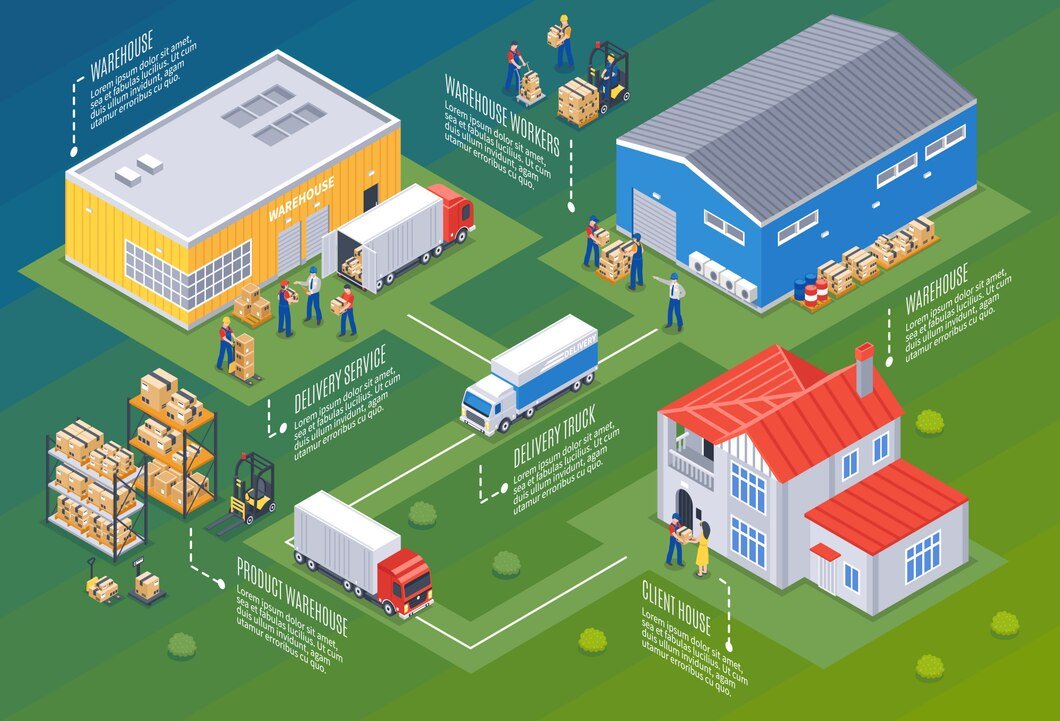Business
Optimizing Warehouse Logistics for a Greener Supply Chain
Published
1 year agoon
By
Ali Ahmed
In the modern business landscape, the push for sustainability is transforming how industries operate, including warehousing and logistics. Warehouses play a crucial role in the supply chain, and optimizing their operations for environmental sustainability not only reduces carbon footprints but also enhances efficiency and cost-effectiveness. Here’s a comprehensive guide on how to optimize warehouse logistics for a greener supply chain.
The Importance of Green Warehousing
Green warehousing involves adopting practices that reduce environmental impact while maintaining or improving efficiency. It encompasses everything from energy consumption and waste management to transportation logistics and resource optimization. Companies that prioritize green warehouse can benefit from reduced operational costs, improved brand reputation, and compliance with environmental regulations.
Key Strategies for Optimizing Warehouse Logistics
To create a greener supply chain, warehouses can implement various strategies that enhance sustainability while optimizing logistics operations.
1. Efficient Space Utilization
Maximizing the use of available space in a warehouse can significantly reduce the need for additional resources and energy. Here’s how to achieve efficient space utilization:
- Vertical Storage Solutions: Use vertical racking systems to store products higher, minimizing the warehouse footprint and reducing heating and cooling requirements.
- Automated Storage and Retrieval Systems (AS/RS): Implement AS/RS to improve storage density and retrieval efficiency, reducing energy usage and enhancing inventory management.
- Layout Optimization: Design warehouse layouts to minimize travel distances for picking and packing, which can reduce energy consumption and increase efficiency.
2. Energy Efficiency and Renewable Energy
Improving energy efficiency and incorporating renewable energy sources are vital steps toward greener warehousing:
- LED Lighting: Replace traditional lighting with energy-efficient LED lights. Use motion sensors and timers to ensure lights are only on when needed.
- Energy Management Systems: Implement systems to monitor and control energy use, optimizing heating, cooling, and lighting based on real-time needs.
- Renewable Energy Sources: Install solar panels or wind turbines to generate clean energy on-site, reducing reliance on non-renewable energy sources.
3. Sustainable Transportation and Logistics
Transportation is a significant contributor to greenhouse gas emissions. Optimizing logistics for sustainability can reduce these emissions:
- Route Optimization: Use advanced software to plan the most efficient delivery routes, minimizing fuel consumption and emissions.
- Load Optimization: Maximize load capacity for each shipment to reduce the number of trips required.
- Eco-Friendly Vehicles: Invest in electric or hybrid vehicles for local deliveries and encourage partners to adopt similar practices.
4. Waste Reduction and Recycling
Implementing waste reduction strategies in warehouses can significantly contribute to sustainability efforts:
- Packaging Optimization: Use minimal, recyclable, or biodegradable packaging materials to reduce waste.
- Recycling Programs: Establish comprehensive recycling programs for materials like cardboard, plastic, and metals.
- Waste Audits: Regularly conduct waste audits to identify areas for improvement and track progress in waste reduction.
5. Advanced Inventory Management
Effective inventory management is crucial for reducing waste and improving logistics efficiency:
- Just-In-Time Inventory: Implement just-in-time inventory practices to reduce excess stock and minimize storage needs.
- Demand Forecasting: Use advanced analytics to predict demand accurately, ensuring the right amount of stock is maintained.
- Automated Inventory Systems: Employ automated systems to track inventory levels in real time, reducing the risk of overstocking or stockouts.
6. Employee Training and Engagement
Engaging employees in sustainability initiatives is essential for their success:
- Sustainability Training: Provide training sessions on sustainable practices and their benefits to encourage adoption.
- Incentive Programs: Implement incentive programs to reward employees for contributing to sustainability goals.
- Green Culture: Foster a company culture that prioritizes sustainability and encourages employees to contribute ideas and solutions.
Benefits of a Greener Supply Chain
Implementing these strategies not only enhances sustainability but also offers several benefits:
Cost Savings
Green warehousing practices often lead to significant cost savings. Energy-efficient lighting and renewable energy can reduce utility bills, while optimized logistics reduce fuel costs. Efficient inventory management minimizes waste, further contributing to cost savings.
Improved Brand Reputation
Companies committed to sustainability are increasingly favored by consumers and partners. By adopting green warehousing practices, businesses can enhance their brand reputation and attract environmentally conscious customers.
Regulatory Compliance
Adhering to environmental regulations is becoming more critical as governments worldwide tighten sustainability requirements. Green warehousing ensures compliance and reduces the risk of penalties or fines.
Enhanced Operational Efficiency
Sustainable practices often lead to streamlined operations and increased efficiency. By optimizing space, energy use, and transportation, warehouses can improve productivity and reduce lead times.
Overcoming Challenges in Green Warehousing
While the benefits of green warehousing are clear, there are challenges to overcome:
Initial Investment
Implementing green technologies and practices may require a significant initial investment. However, the long-term savings and benefits often outweigh these costs.
Change Management
Shifting to sustainable practices requires a change in mindset and processes. Effective communication and training are essential to ensure successful adoption across the organization.
Technology Integration
Integrating new technologies into existing systems can be complex. Working with experienced partners and investing in scalable solutions can ease the transition.
Conclusion
Optimizing warehouse logistics for a greener supply chain is a vital step toward sustainability. By implementing strategies such as efficient space utilization, energy efficiency, sustainable transportation, and waste reduction, warehouses can significantly reduce their environmental impact while improving efficiency and cost-effectiveness. Embracing green warehousing not only benefits the planet but also enhances business operations, making it a win-win for companies committed to a sustainable future.
You may like


Why Companies Worldwide Are Hiring Power BI Developers

Experience Pure Android Gameplay with MuMuPlayer Emulator

A Guide To Solar PV For Homeowners

How to Convert a Historic Building into a Hotel: a 2025 Guide

How You Can Integrate AI into Your Small Business For Faster Growth

File Recovery on Android: Myths vs. Facts

Cooler, Safer, Clearer: Why Quality Window Tint Is a Smart Upgrade in 2025

How Medium-Sized Businesses Actually Handle Their Books

Best Travel Vacuum Bags: Pack More and Worry Less with Vacbird Storage Bags

Start Your Morning Right: The Real Benefits of Himalayan Pink Salt and Lemon Water

Carol Kirkwood’s Journey: Her Real Age, Husband, Career, and More

Revolutionizing Healthcare: The Emergence of AI-Driven Analytics

How Machine Learning and AI are Redefining the Future?

Aliza Barber: Meet Lance Barber’s Wife, Age, Life, Profile, Career and Net Worth

Evelyn Melendez: Jordan Knight’s Wife Bio, Marriage, Family, Career and Net Worth

Ilan Tobianah Biography: Family, Marriage, Lifestyle, Career and Net Worth

Who was Alice Marrow? Everything to Know About Ice-T’s and His Mother

King Von’s Autopsy Report: The Truth Behind the Tragic Death

Meet Otelia Cox: The Supportive Wife of Tony Cox – A True Fairy Tale Romance

Tea Leoni and Tim Daly Split – A Closer Look at Their Relationship and Breakup

Why Companies Worldwide Are Hiring Power BI Developers

Experience Pure Android Gameplay with MuMuPlayer Emulator

A Guide To Solar PV For Homeowners

How to Convert a Historic Building into a Hotel: a 2025 Guide

How You Can Integrate AI into Your Small Business For Faster Growth

File Recovery on Android: Myths vs. Facts

Cooler, Safer, Clearer: Why Quality Window Tint Is a Smart Upgrade in 2025

How Medium-Sized Businesses Actually Handle Their Books

Best Travel Vacuum Bags: Pack More and Worry Less with Vacbird Storage Bags

Start Your Morning Right: The Real Benefits of Himalayan Pink Salt and Lemon Water
Category
Trending
-

 News3 months ago
News3 months agoCarol Kirkwood’s Journey: Her Real Age, Husband, Career, and More
-

 Health2 years ago
Health2 years agoRevolutionizing Healthcare: The Emergence of AI-Driven Analytics
-

 Technology2 years ago
Technology2 years agoHow Machine Learning and AI are Redefining the Future?
-

 Celebrity2 years ago
Celebrity2 years agoAliza Barber: Meet Lance Barber’s Wife, Age, Life, Profile, Career and Net Worth
